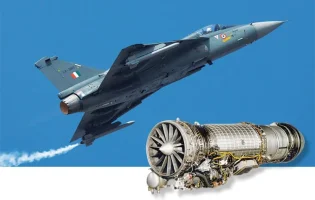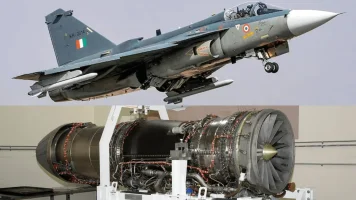- Views: 2K
- Replies: 10
The Indian Air Force (IAF) is set to significantly bolster its combat capabilities as the domestically developed Light Combat Aircraft (LCA) Tejas Mk1A approaches final trials for combat certification with the advanced French AASM HAMMER missile system.
The Tejas Mk1A has already been observed flying with this precision-guided munition.
The AASM HAMMER (Highly Agile Modular Munition Extended Range), produced by Safran Electronics & Defence, is a sophisticated weapon capable of striking targets up to 70 kilometres away.
It is designed for various critical missions, including providing close air support to ground troops, conducting precise strikes on high-value targets, and notably, for the Suppression of Enemy Air Defences (SEAD) – missions aimed at neutralising an adversary's air defence systems.
The HAMMER missile system is already operational on the IAF’s Rafale fighter jets. Its integration with the Tejas Mk1A is a strategic enhancement for India’s air combat strength, particularly important in the context of the nation's security considerations with neighbouring countries.
The process of integrating the AASM HAMMER with the Tejas Mk1A commenced in 2020, marking several important achievements over the last five years.
In November 2021, an official from Hindustan Aeronautics Limited (HAL) confirmed that the Aeronautical Development Agency (ADA) had secured an agreement for a number of HAMMER kits for the Tejas program.
Key testing milestones were achieved on March 31, 2022, when ground jettison tests were successfully carried out from the aircraft’s mid-board station using a Limited Series Production (LSP-7) Tejas. These were followed by successful release tests of the HAMMER missile, concluding the first phase of its integration.
Recent reports from earlier this year indicate that the Tejas Mk1A has been actively flying with the HAMMER system during ongoing trials. Sources also suggest that the integration process is nearing completion for the older Tejas Mk1 variant as well.
The AASM HAMMER is a combat-proven, modular system that converts standard unguided bombs of various weights (125 kg, 250 kg, 500 kg, and 1,000 kg) into highly accurate, rocket-boosted smart munitions using a guidance kit.
Key advantages of the HAMMER system include its 70-kilometre standoff range, which allows the Tejas to engage targets from a safer distance, thereby reducing its vulnerability to enemy air defences. It is versatile, supporting missions against targets such as fortified bunkers, radar installations, and mobile threats.
The HAMMER offers multiple guidance options – including INS/GPS, INS/GPS combined with Infrared (IR), and INS/GPS with Laser guidance – ensuring high precision even in environments where GPS signals might be jammed. Its resilience against electronic warfare, a capability demonstrated effectively in Ukraine against Russian jamming attempts, further underscores its reliability.
On the Tejas aircraft, the HAMMER missiles are mounted on the mid-board weapon stations, complementing other munitions carried by the fighter, such as the Astra Mk1 air-to-air missile and the Python-5. The integration takes full advantage of the Tejas’s advanced avionics for seamless targeting and deployment.
The SEAD capability provided by the HAMMER is particularly crucial. It enables the Tejas to effectively identify and neutralise enemy radar and missile systems, such as Pakistan’s HQ-9B or similar systems operated by China, thereby enhancing the IAF's ability to operate within and penetrate contested airspace.
Furthering India's self-reliance goals in the defence sector, Bharat Electronics Limited (BEL) and Safran announced a joint venture on February 12, 2025. This collaboration aims to localise the production of AASM HAMMER missiles in India, encompassing manufacturing, customisation, sales, and through-life maintenance.
This strategic partnership directly supports the 'Aatmanirbhar Bharat' initiative, aiming to reduce India's dependence on imports and strengthen its domestic defence industrial base and supply chain resilience.
The formalisation of this joint venture followed a French proposal for co-development in October 2024 and builds upon the existing integration of the HAMMER system with the IAF's Rafale and Mirage 2000 fleets, ensuring valuable interoperability across different fighter platforms.



